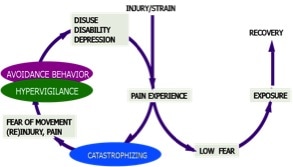A Learning Theory Perspective on Pain-related Fear in Chronic Pain
There is no doubt that there is heaps of wisdom in the Star Wars saga. For example, Master Yoda said once: “Fear is the path to the dark side”. When it comes to chronic pain, and in particular how acute pain might turn into chronic pain, Yoda’s quote is spot on! Fear-avoidance models consider pain-related fear as an important factor in the development and maintenance of chronic musculoskeletal pain (Vlaeyen & Linton, 2000, 2012). More than a decade ago Crombez et al. (1999) demonstrated that pain-related can even be more disabling than pain itself. In the light of these findings, it seems important to find out how people acquire fear of pain and even more importantly, once established, how can we get rid of this fear?
Fear acquisition and pain (un)predictability
Contemporary models of classical fear conditioning (Mitchell et al., 2009; Rescorla & Wagner, 1972) provide a rich theoretical framework to understand how fear of pain can be acquired. Fear conditioning occurs when a neutral cue, e.g., a movement (conditioned stimulus = CS) is (repeatedly) paired with an aversive event, e.g., pain (unconditioned stimulus = US). By virtue of propositional knowledge relating pain to an initially neutral movement this movement starts to signal danger/harm and comes to elicit subjective and autonomic fear responses and to spur avoidance behavior. Although fear conditioning research and its application to pain-related fear has been fruitful for the understanding of chronic regional musculoskeletal pain (e.g., low back pain), it may not be appropriate for more generalized pain disorders. Patients with generalized musculoskeletal pain (e.g., fibromyalgia) are not able to predict fluctuations in pain. These patients are more generally afraid of (re)injuring themselves or worsening their pain and as they have no clear predictors for increasing pain episodes, they tend to avoid a broader range of activity. When it comes to functional disability these patients are worse off. Probably because apparent safety cues are lacking, experiencing an unpredictable threat induces a more general form of distress, demonstrated by feelings of worry and chronic apprehension (Mineka & Kihlstrom,1978).
Proprioceptive fear conditioning: a voluntary joystick movement paradigm
Proprioception is restrictively defined as the perception of posture and movement, also referred to as postural somesthesis. Proprioceptive fear conditioning is particularly relevant and more ecologically valid for patients with pain in the musculoskeletal system. Therefore, we developed a novel pain-relevant fear conditioning paradigm using proprioceptive CSs and painful electrocutaneous stimuli as US (Meulders et al., 2011). This paradigm used joystick movements, of which the direction predicted painful shock to the hand (e.g., moving to the left was followed by shock (CS+) and moving to the right was never followed by shock (CS-)). In another condition painful stimuli were delivered unpredictably, so both movements (e.g., moving up/down) were explicitly unpaired with the painful shock. Results showed higher levels of conditioned fear responding elicited by the CS+ movement than by the CS- movement (elevated fear-potentiated eyeblink startle and verbal fear ratings). Participants were also slower in initiating the painful movement than the non-painful movement, suggesting that they were avoiding the movement that predicted pain. No such differences were found for both unpredictable movements, but responses were overall higher compared with the CS- movement in the predictable condition, although they are functionally equivalent (i.e., never followed by shock). Together with elevated eyeblink startle responses during the context alone, these results suggest that a more chronic anticipatory, generalized pain-related fear was produced by our unpredictable pain manipulation. Taken together, these findings confirm that fear of movement and generalized pain-related fear can be acquired through associative learning in healthy individuals.
The degree of predictability may affect the experienced pain intensity as well. Indeed, an interesting finding in another study using joystick movements was that in the unpredictable condition, both pain intensity and pain unpleasantness were rated higher as compared with the predictable condition, despite the equal number and physical intensities of the stimuli (Meulders et al., 2012). The role of predictable vs. unpredictable pain clearly warrants more systematic experimental scrutiny as it may shed light on the pathogenesis of generalized pain syndromes. So, now you know how pain-related fear can be acquired, next time we will get down to serious business, that is, how to get rid of this pain-related fear.
For the time being: May the Force be with you!
About Ann Meulders
 Ann is currently working as a postdoctoral fellow in the Research Group on Health Psychology at University of Leuven. During her PhD research (at the Center of Learning and Experimental Psychopathology) she was already flirting with fundamental learning theory and had a particular crush on classical conditioning models to experimentally study fear and anxiety in the lab. As true love never fades, her current ambition is to apply her fear conditioning expertise in the domain of chronic pain. Ann is particularly interested in pain-related fear conditioning and pain unpredictability, and more specifically in how predictable vs. unpredictable pain affects the acquisition, generalization, and extinction of pain-related fear and avoidance as well as how it alters the perception of pain itself.
Ann is currently working as a postdoctoral fellow in the Research Group on Health Psychology at University of Leuven. During her PhD research (at the Center of Learning and Experimental Psychopathology) she was already flirting with fundamental learning theory and had a particular crush on classical conditioning models to experimentally study fear and anxiety in the lab. As true love never fades, her current ambition is to apply her fear conditioning expertise in the domain of chronic pain. Ann is particularly interested in pain-related fear conditioning and pain unpredictability, and more specifically in how predictable vs. unpredictable pain affects the acquisition, generalization, and extinction of pain-related fear and avoidance as well as how it alters the perception of pain itself.
References
Crombez G, Vlaeyen JW, Heuts PH, & Lysens R (1999). Pain-related fear is more disabling than pain itself: evidence on the role of pain-related fear in chronic back pain disability. Pain, 80 (1-2), 329-39 PMID: 10204746
Meulders A, Vansteenwegen D, & Vlaeyen JW (2011). The acquisition of fear of movement-related pain and associative learning: a novel pain-relevant human fear conditioning paradigm. Pain, 152 (11), 2460-9 PMID: 21723664
Meulders A, Vansteenwegen D, & Vlaeyen JW (2012). Women, but not men, report increasingly more pain during repeated (un)predictable painful electrocutaneous stimulation: Evidence for mediation by fear of pain. Pain, 153 (5), 1030-41 PMID: 22401700
Mineka S, & Kihlstrom JF (1978). Unpredictable and uncontrollable events: a new perspective on experimental neurosis. Journal of abnormal psychology, 87 (2), 256-71 PMID: 565795
Mitchell CJ, De Houwer J, & Lovibond PF (2009). The propositional nature of human associative learning. The Behavioral and brain sciences, 32 (2) PMID: 19386174
Rescorla, R.A., & Wagner, A.R. (1972). A theory of Pavlovian conditioning: Variations in the effectiveness of reinforcement and nonreinforcement. In A.H. Black, & W.F. Prokasy, eds. Classical conditioning II, pp. 532-552. New York: Appleton-Century-Crofts.
Vlaeyen JW, & Linton SJ (2000). Fear-avoidance and its consequences in chronic musculoskeletal pain: a state of the art. Pain, 85 (3), 317-32 PMID: 10781906
Vlaeyen JW, & Linton SJ (2012). Fear-avoidance model of chronic musculoskeletal pain: 12 years on. Pain, 153 (6), 1144-7 PMID: 22321917



